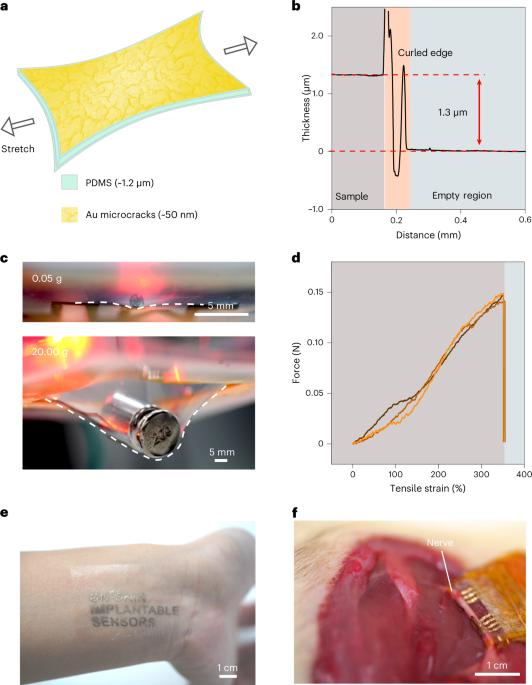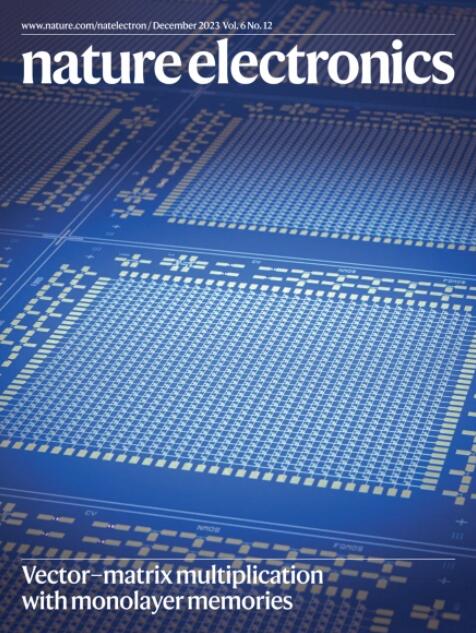A 1.3-micrometre-thick elastic conductor for seamless on-skin and implantable sensors
IF 33.7
1区 工程技术
Q1 ENGINEERING, ELECTRICAL & ELECTRONIC
引用次数: 21
Abstract
On-skin and implantable electronics require elastic conductors that are only a few micrometres thick and soft enough to form a seamless contact with three-dimensional structures. However, fabricating thin conductors that are mechanically durable and have consistent electrical properties with stretching is challenging. Here we report polydimethylsiloxane (PDMS)–gold conductors that are around 1.3 µm thick and have a controlled morphology of microcracks in the gold film. The microcracks are formed by evaporating a 50-nm-thick gold film onto a 1.2-µm-thick PDMS film that is supported during fabrication by a 100-µm-thick PDMS film on glass; thermal expansion of the thick PDMS film causes the evaporated gold to form a microcracked structure on the thin PDMS. The resulting conductors can be stretched by up to 300% and remain highly conductive after strain release. We use them to create on-skin electrodes that are breathable and water resistant, and can continuously record electrocardiogram signals. We also use the conductors to create on-skin sensors with less than 3 µm thickness that can detect small mechanical forces and create implantable nerve electrodes that can provide signal recording and stimulation. Polydimethylsiloxane–gold conductors that are 1.3 μm thick and have controlled morphology of microcracks in the gold film can be used to create breathable and water-resistant electrodes for recording electrocardiogram signals, as well as on-skin pressure sensors and implantable nerve electrodes.

一种1.3微米厚的弹性导体,用于无缝皮肤和植入式传感器
皮肤和植入式电子设备需要厚度仅为几微米、柔软度足以与三维结构形成无缝接触的弹性导体。然而,要制造出既具有机械耐久性,又能在拉伸过程中保持稳定电气性能的薄导体,却极具挑战性。在此,我们报告了厚度约为 1.3 µm 的聚二甲基硅氧烷 (PDMS) - 金导体,其金膜上的微裂缝形态可控。微裂缝是通过在 1.2 微米厚的 PDMS 薄膜上蒸发 50 纳米厚的金膜而形成的,在制造过程中,该薄膜由玻璃上 100 微米厚的 PDMS 薄膜支撑;厚 PDMS 薄膜的热膨胀导致蒸发的金在薄 PDMS 上形成微裂缝结构。由此产生的导体可拉伸 300%,并在应变释放后保持高导电性。我们用它们制造出透气、防水、可连续记录心电信号的皮肤电极。我们还利用这种导体制造了厚度小于 3 微米的皮肤传感器,可检测微小的机械力,并制造了可提供信号记录和刺激的植入式神经电极。厚度为 1.3 微米、金膜微裂纹形态可控的聚二甲基硅氧烷金导体可用于制造记录心电信号的透气防水电极,以及皮肤压力传感器和植入式神经电极。
本文章由计算机程序翻译,如有差异,请以英文原文为准。
求助全文
约1分钟内获得全文
求助全文
来源期刊

Nature Electronics
Engineering-Electrical and Electronic Engineering
CiteScore
47.50
自引率
2.30%
发文量
159
期刊介绍:
Nature Electronics is a comprehensive journal that publishes both fundamental and applied research in the field of electronics. It encompasses a wide range of topics, including the study of new phenomena and devices, the design and construction of electronic circuits, and the practical applications of electronics. In addition, the journal explores the commercial and industrial aspects of electronics research.
The primary focus of Nature Electronics is on the development of technology and its potential impact on society. The journal incorporates the contributions of scientists, engineers, and industry professionals, offering a platform for their research findings. Moreover, Nature Electronics provides insightful commentary, thorough reviews, and analysis of the key issues that shape the field, as well as the technologies that are reshaping society.
Like all journals within the prestigious Nature brand, Nature Electronics upholds the highest standards of quality. It maintains a dedicated team of professional editors and follows a fair and rigorous peer-review process. The journal also ensures impeccable copy-editing and production, enabling swift publication. Additionally, Nature Electronics prides itself on its editorial independence, ensuring unbiased and impartial reporting.
In summary, Nature Electronics is a leading journal that publishes cutting-edge research in electronics. With its multidisciplinary approach and commitment to excellence, the journal serves as a valuable resource for scientists, engineers, and industry professionals seeking to stay at the forefront of advancements in the field.
 求助内容:
求助内容: 应助结果提醒方式:
应助结果提醒方式:


